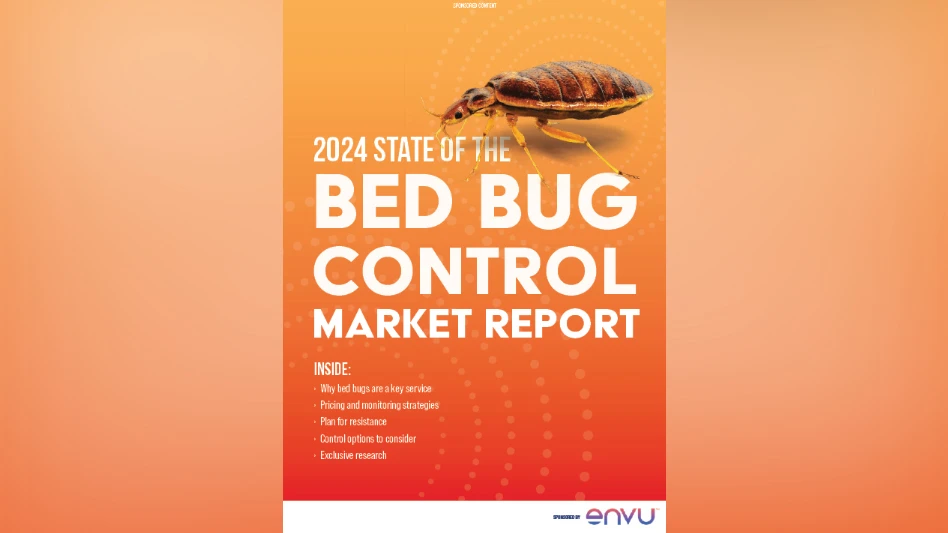
Many pests are like people in the winter. When temperatures drop, we head indoors. If there’s food and a comfortable place to hang out, we’re there. And after a lot of rain, we can’t wait to get out and run around.
“Virtually all of the pest problems we see are influenced by weather one way or another,” says Dr. Philip Koehler, an endowed professor specializing in urban entomology at the University of Florida.
“Insects are not able to regulate their own temperatures,” he continues. “So, they rely on the weather to regulate it for them. There are things they do to modify that on their own, such as move to a place that is warmer.”
With winter weather underway and circulating predictions about how long, cold, wet and snowy the first quarter of 2017 will be, the real question is: What does this mean for pest pressure — and, of course, your business?
Partho Dhang, Ph.D., an urban entomologist studying climate change as it relates to pests, says temperature is the most important environmental factor influencing pest behavior, distribution, development, survival and reproduction. “It has been estimated that with a 2°C rise in temperature, insects might experience one to five additional life cycles per season,” he says.
That’s pest pressure.
Overall, 2016 was the warmest year since weather records were kept, Dhang points out. But what about 2017? Forecasters at the National Oceanic and Atmospheric Administration (NOAA) Climate Prediction Center issued a U.S. Winter Outlook saying La Niña will influence this year’s conditions. La Niña means drier, warmer winters in the South — and wetter, cooler conditions in the North.
The National Pest Management Association (NPMA) Bug Barometer released for fall/winter 2016-17 predicted that extreme summer weather will affect fall and winter pest pressure. It calls for more mosquitoes and rodents in the Southeast, strong stinging insect and rodent populations in the Northeast, and a boost in mosquito populations in the Southwest and West Coast.
PCT magazine gathered insight from weather and pest pressure predictions, entomologists and professionals in the field. But just ask your local meteorologist: It’s easier to write a recap than a forecast. Weather can be a gamble.
TREND-SPOTTING. Winter is a different kind of season depending on where you operate your business. In Florida, mosquitoes fly year-round. In fact, Koehler points out that about one-third of pest control treatments in the U.S. occur in Florida. About 20 percent of the industry is based in the Sunshine State.“But animals and pests are spreading farther north than they ever were able to survive before, so maybe the type of industry we have here in Florida will also spread farther north,” he speculates.
WARMER WEATHER. Higher temperatures throughout the country are creating pathways for pests to travel beyond what would have been their typical comfort zones.Generally, a northern winter is not so comfy for outdoor insects. They tend to go dormant or overwinter, Dhang says. Some insects even die. “But changes in winter weather, such as (a) shorter winter, warm and moist winter, late arrival of winter, will encourage pest insects to remain active longer and have additional life cycles,” he says.
Dhang relates some examples in his publication, Climate Change Impact on Urban Pests. For example, he explains how the St. Louis, Mo., area experienced termite swarming earlier in the year after a mild winter in 2011-12. “The mild winter was followed by a very warm and dry summer, and this was also associated with a significant increase in houses invaded by brown recluse spiders that normally reside outdoors,” Dhang writes, citing a study by Sims and Appel illustrating weather-influenced effects on pests.
Another study by Dhang references an increase in the geographic range of mosquitoes following warm temperatures. “This serves as another example of how temperature can influence urban pests dynamics,” he says.
So temperature is king when predicting pest pressure. But moisture is also a big deal. “Warm temperatures in the absence of moisture can be a limiting factor for pests,” Dhang notes. Insects desiccate in hot, dry conditions.
MOISTURE MATTERS. Koehler points to the drought conditions in the Southeast and a slowdown of pest pressure in terms of complaints from customers finding insects indoors.
Dry weather can squelch pest production. But, once the rain returns that activity picks back up. That’s what Clark Pest Control in California experienced, says Nicole Kirwan Keefe, director of marketing and advertising for the company.
“We had one of the wettest Octobers in 2016 that we’ve had in a long time, following a long, dry run,” Keefe says. November was the busiest business month on record. “I can’t miss the correlation between one of the wettest Octobers and the busiest November.”
Keefe thinks the wet weather caused a spike in pest activity, then in November some of these pests were driven inside. (This is also the time when people are unpacking their holiday boxes from garages, which tends to stir up pests.)
“We saw a lot of heavy ant activity, and on the coast we did see some termite activity spike up (in November),” Keefe says.
Following winter 2017, Keefe expects lots of weed work and clearing of harborage spaces. “Weeds are growing like crazy around homes with all those early rains,” she says. “We are going to have a lot of harborage areas that will increase pest activity.”
The opposite of drought — flooding — has greatly impacted pest pressure in areas like New Orleans, points out Gregg Henderson, Paul K. Adams endowed professor of urban entomology at Louisiana State University. For the last 27 years, his studies have focused on Formosan subterranean termites. “If it is too dry or too cold, termites can’t forage very well,” he says.
Drowning experiments showed that it takes about 30 hours for termites to die in water. “They stop moving right away, but even when you take them out of water after about 15 hours, they will be fine,” Henderson says.
Henderson reflects on 2006, when the Gulf Coast experienced significant rainfall during Hurricane Katrina: “That was the biggest drop in winged termites in New Orleans we saw in 20 years,” he says.
In 2016, the region experienced flooding followed by drought. “Those two conditions are not conducive for termites to grow very well,” Henderson relates. “Having said that, I expect the new areas where Formosan subterranean termites evolve (to produce swarms), and as they move further north their numbers will grow.”
RODENTS ON THE RISE. Meanwhile, we’ve been hearing a lot about rodent activity in 2016, which is expected to continue in much of the country in 2017. (The exception based on the Bug Barometer is the Pacific Northwest, which is expected to have smaller rodent populations because of warmer, drier conditions.) But once rodents get a feel of cool weather, they’ll move indoors. “Rodents are warm-blooded and they’ll generate heat to warm each other up,” Henderson says, relating how they tend to stay together in family units and shiver to create a shared heat source. “As long as we don’t get too many sub-freezing temperatures here, rodents will be fine.”
Koehler notes that the introduction of invasive pests such as the marmorated stink bug and kudzu bug have resulted in increased numbers of pests. And, these pests tend to move indoors when a weather event occurs. “Asian lady beetles can be beneficial outside, but once they move indoors they can stain walls and, if they die, they become food for other domestic insects like domestic beetles,” he says.
THE IMPACT OF SNOW. Jim Skinner heard this winter could bring cold temperatures where AC Pest Management is based in East Meadow, N.Y. He remembers back in winter 2014, when frigid temperatures resulted in very low pest activity/initial calls in the first part of the year. “We were way down six months into the year,” he says, adding that business perked up in the summer with lots of bee and wasp work.“Thank goodness for bed bugs that year,” Skinner recalls.
With this year’s La Niña predicted heavy snows in the Great Lakes and Northeast, PMPs could see increased activity from pests like carpenter ants that gravitate toward ice jams. Same goes for pavement ant activity, Skinner says. “Those insects come up through the cracks and crevices in the house, especially when we get ice jams that freeze in the gutter and come back underneath the fascia board(s) of homes,” he explains.
A snowy winter that is not too bitter cold like several years ago could spark carpenter and pavement ant calls. And there are always rodents, which like to head indoors, Skinner says.
Dan Fleischer, owner of PestEx in Framingham, Mass., notices a correlation between acorn drop in the fall and rodent activity in winter. (And it makes sense — squirrels aren’t the only critters that like to feed on these goodies.)In New England, the same goes with ice jams providing harborage sites for carpenter ants. And, flooding/moisture in and around homes creates desirable environmental conditions for pests.
WARM, WET CONDITIONS. Dhang says these conditions trigger pest activity because pests do not go dormant. “Snowfall and moisture will add a high level of moisture to the soil and environment, and combined with higher or warm temperatures, pests could have additional life cycles.”
That translates to higher populations than normal at the onset of summer, Dhang says.
In the Southeast — and many parts of the country — an unseasonably warm, long fall meant more insect activity later in the year. “So that means with cold fronts coming in, there are going to be more insects moving inside,” Koehler says.
Koehler noted a large number of mosquitoes in fall because of weather fronts depositing rain. The bugs had just the right conditions: appealing temperatures and moisture.
FRIGID COLD. On the other hand, a very cold winter will force most insects into dormancy or over-wintering. Cold winters impact outdoor insects like mosquitoes, flies, termites, garden pests and others. “But pests that live in close proximity to humans, such as (the) German cockroach, bed bugs, fleas on pets, lice and indoor wood beetles, are not influenced by winter,” Dhang points out.
You know that winter that never seems to end? If we have one of those, “that will keep pest populations in check,” Dhang says.
With La Niña, the southern and northern parts of the country will be experiencing the extremes.
FINAL PREDICTIONS. Overall, predicting pest pressure today is different than several years ago because our weather patterns are more extreme, Keefe says. “I can tell you the bugs haven’t stopped,” she says. “But they have changed their patterns as we have seen a lot of changing weather.”
What’s important when planning for business is to look at longer, even annual, weather cycles. “A weather system or storm is too small of a window to make a prediction on what the next year will look like,” Henderson says. “The weather for an entire year really needs to be considered when thinking about whether an insect population is going to grow or reduce.”
Weather or not, pest control is a consistent business — it’s the type of pests that evolve and fluctuate. And bed bugs, as Skinner noted, have been a real boon to the industry with year-round indoor pressure, creating an important new profit center for many pest management professionals.
“Every year is a good year for pests,” Koehler says. “It just depends on which pests fare better in wet conditions, and which pests do better in dry conditions.”
The author is a frequent contributor to PCT.

Explore the January 2017 Issue
Check out more from this issue and find your next story to read.
Latest from Pest Control Technology
- Tracking Rats in Crawlspaces
- Process of Elimination During Fly Inspections
- Cascade Pest Owner Treftz Encourages Continued Education with A.C.E. Credentials
- Cutting-Edge Identification Tips, Technical Research Discussed at UK Short Course
- NYPMA Hosts Educational Conference on Innovative Topics, Best Practices
- Pest-End Acquires Master Mosquito Control
- Certus Pest Acquires Aardvark Ant & Pest Control
- Early Registration Open for ICUP 2025





